
Euphorbia is a very large and diverse genus of flowering plants, commonly called spurge, in the spurge family (Euphorbiaceae). "Euphorbia" is sometimes used in ordinary English to collectively refer to all members of Euphorbiaceae, not just to members of the genus. Some euphorbias are commercially widely available, such as poinsettias at Christmas. Some are commonly cultivated as ornamentals, or collected and highly valued for the aesthetic appearance of their unique floral structures, such as the crown of thorns plant. Euphorbias from the deserts of Southern Africa and Madagascar have evolved physical characteristics and forms similar to cacti of North and South America, so they are often incorrectly referred to as cacti. Some are used as ornamentals in landscaping, because of beautiful or striking overall forms, and drought and heat tolerance.

In botany, a bract is a modified or specialized leaf, especially one associated with a reproductive structure such as a flower, inflorescence axis or cone scale. Bracts are often different from foliage leaves. They may be smaller, larger, or of a different color, shape, or texture. Typically, they also look different from the parts of the flower, such as the petals or sepals. The state of having bracts is referred to as bracteate or bracteolate, and conversely the state of lacking them is referred to as ebracteate and ebracteolate, without bracts.

The Boro is the largest ethnolinguistic group in the Assam state of India. They are a part of the greater Bodo-Kachari family of ethnolinguistic groups and are spread across northeastern India. They are concentrated mainly in the Bodoland Territorial Region of Assam, though Boros inhabit all other districts of Assam.
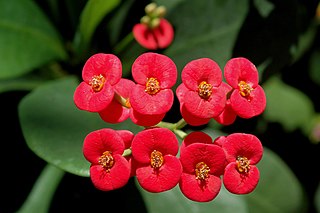
Euphorbia milii, the crown of thorns, Christ plant, or Christ thorn, is a species of flowering plant in the spurge family Euphorbiaceae, native to Madagascar. The species name commemorates Baron Milius, once Governor of Réunion, who introduced the species to France in 1821. It is imagined that the species was introduced to the Middle East in ancient times, and legend associates it with the crown of thorns worn by Christ. It is commonly used as an ornamental houseplant that can be grown in warmer climates. The common name is due to the thorns and deep red bracts referring to the crown thorn Jesus had to wear during his crucification and his blood.

Citrus medica var. sarcodactylis, or the fingered citron, is an unusually shaped citron variety whose fruit is segmented into finger-like sections, resembling those seen on representations of the Buddha. It is called Buddha's hand in Chinese (佛手柑), Japanese (仏手柑), Korean, and French.
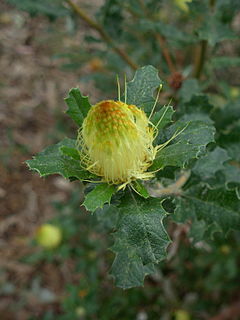
Banksia undata, commonly known as urchin dryandra, is a species of shrub that is endemic to the southwest of Western Australia. It has sessile, wedge-shaped, wavy, serrated leaves, pale yellow flowers in heads of between 80 and 160, and later up to eight follicles in each head.

Euphorbia candelabrum is a succulent species of plant in the family Euphorbiaceae, one of several plants commonly known as candelabra tree. It is closely related to 3 other species of Euphorbia in particular; Euphorbia ingens in the dry regions of South Africa, Euphorbia conspicua from western Angola, and Euphorbia abyssinica which is native to a number of countries including Sudan, Eritrea, Djibouti, Ethiopia and Somalia.
Banksia undata var. splendens is a shrub endemic to Western Australia.

The Euphorbiaceae, the spurge family, are a large family of flowering plants. In common English, they are sometimes called euphorbias, which is also the name of a genus in the family. Most spurges such as Euphorbia paralias are herbs, but some, especially in the tropics, are shrubs or trees, such as Hevea brasiliensis. Some, such as Euphorbia canariensis, are succulent and resemble cacti because of convergent evolution. This family occurs mainly in the tropics, with the majority of the species in the Indo-Malayan region and tropical America a strong second. A large variety occurs in tropical Africa, but they are not as abundant or varied as in the two other tropical regions. However, the Euphorbiaceae also have many species in nontropical areas such as the Mediterranean Basin, the Middle East, South Africa, and the Southern United States.

The Huntington Desert Garden is part of The Huntington Library, Art Collections and Botanical Gardens in San Marino, California. The Desert Garden is one of the world's largest and oldest collections of cacti, succulents and other desert plants, collected from throughout the world. It contains plants from extreme environments, many of which were acquired by Henry E. Huntington and William Hertrich in trips taken to several countries in North, Central and South America. One of the Huntington's most botanically important gardens, the Desert Garden brought together a group of plants largely unknown and unappreciated in the beginning of the 1900s. Containing a broad category of xerophytes, the Desert Garden grew to preeminence and remains today among the world's finest, with more than 5,000 species in the 10 acre garden.
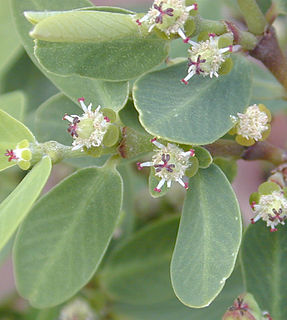
Euphorbia celastroides is a flowering plant in the family Euphorbiaceae. It is referred to by the common name 'akoko by Hawaiians, and is a species of spurge closely related to the poinsettia. This species develops into a round-shape shrub. This species is endemic to the Hawaiian Islands.
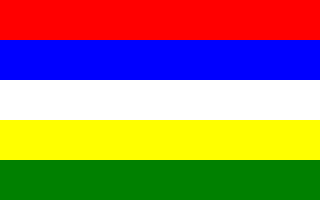
Bathouism (बाथौ) is the ethnic religion of the Bodo people or Kachari people. The name Bathou in Bodo means five principles. The five principles are: bar (air), orr (fire), ha (earth), dwi (water) and okhrang (ether). The chief deity, called Bathoubwrai —omnipresent, omniscient and omnipotent—is said to have created the five principles. Though there are other minor gods and goddesses, Bathoubwrai is considered the Supreme God. Bathoubwrai is unseen. The second most important deity is Mainao, the consort of Bathoubwrai, who is considered as the "protector of the rice fields".
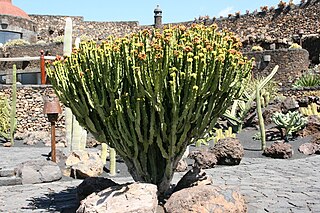
Euphorbia abyssinica, commonly known as the desert candle or candelabra spurge, is a species of plant in the family Euphorbiaceae. E. abyssinica is endemic to Ethiopia, Somalia, Sudan and Eritrea. It was first described in 1791, by the German botanist Johann Friedrich Gmelin. In its native habitat, it can grow up to 10 m (33 ft) tall. The woody stem is used for firewood and as timber in roofing, furniture and other items, and the sap is used in traditional medicine. It is also cultivated as an ornamental house plant.
This is a list of plants found in the Sierra de Manantlán Biosphere Reserve. The reserve straddles the Mexican states of Colima and Jalisco. It is located in the transition between the Nearctic and Neotropical realms and encompasses parts of the Sierra Madre del Sur, with a wide range of altitudes, climates and soils. The effects of tectonic and volcanic activities and erosion are notable within the reserve.

Ulmus minorvar.italica was first described by Augustine Henry in 1913, as a 'variety' of field elm from Italy, Spain, Portugal and Algeria. He called it Ulmus nitens var. italica, 'Mediterranean Elm'. The variety was accepted by Krüssman (1984), despite the wide source-area claimed for it, as a non-clonal cultivar, U. carpinifolia var. italicaHenry. Bean (1988), however, considered it "a variety of rather dubious standing", and it was ignored by Richens (1983), who listed instead a "small-leaved U. minor of Spain" and a "narrow-leaved U. minor of northern and central Italy", as well as "the densely hairy leaved U. minor of southern Italy", the latter being Ulmus minor subsp. canescens, formerly Melville's Ulmus canescens.
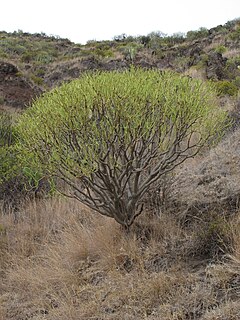
Euphorbia lamarckii is a species of flowering plant in the family Euphorbiaceae, native to the western Canary Islands. It resembles Euphorbia regis-jubae, with which it has been confused. Both have been called Euphorbia obtusifolia.














